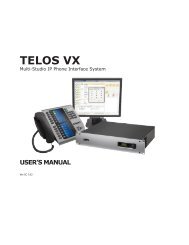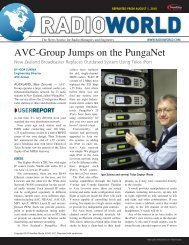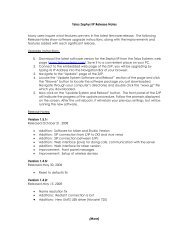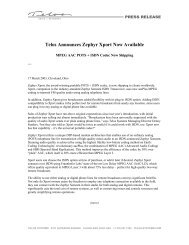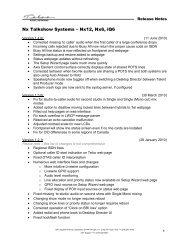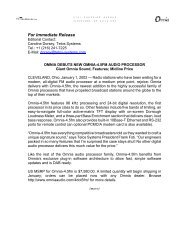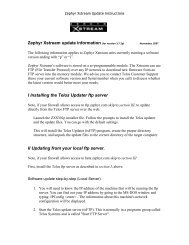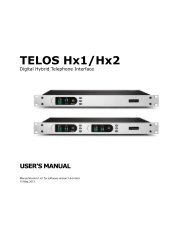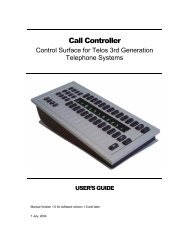NOW! 12-13 - Telos
NOW! 12-13 - Telos
NOW! 12-13 - Telos
Create successful ePaper yourself
Turn your PDF publications into a flip-book with our unique Google optimized e-Paper software.
AXIA | NETWORKING | TECHNOLOGY ARTICLE<br />
96<br />
EVOLUTION<br />
AoIP IN BROADCAST ENGINEERING<br />
This year we celebrate a decade since the irst public demonstration<br />
of AoIP. Does that seem too long a time? It’s not — although<br />
oficially revealed a year later in 2003, Livewire actually<br />
debuted at NAB in 2002. Sitting hidden inside <strong>Telos</strong> display furniture,<br />
it was secretly powering the demo of our SmartSurface<br />
mixing console. So it seems appropriate that we look back on<br />
how AoIP began and evolved, see where it has taken us today,<br />
and maybe take a peek into the future.<br />
PRO AUDIO OVER IP? THAT’S CRAZY! OR IS IT?<br />
By the late 1990’s, data networking was already present in<br />
everyday activities. There was a good selection of reasonably<br />
priced networking devices and cabling materials on the market,<br />
and connecting a basic ofice data network was a relatively<br />
easy, almost plug-and-play task, thanks to the huge effort that<br />
the computer and data networking industry had been making<br />
for many years.<br />
Radio broadcast facilities were no exception — on the ofice<br />
side, at least. But in the studio? Racks of tremendously expensive<br />
special-purpose equipment, and tons of cabling could still<br />
be found there. The equipment at the heart of broadcast radio<br />
was, back then, far behind that of the data networking industry.<br />
In October, 2000, Steve Church visited the Real-Time Systems<br />
laboratory at the University of Latvia, bringing with him an<br />
extremely interesting document: a technical outline of a<br />
completely new approach to building audio infrastructure<br />
for a modern radio broadcast facility, based on using standard<br />
Ethernet/IP-based protocols and off-the-shelf data<br />
network equipment.<br />
Two major misconceptions stood in the way of introducing<br />
modern data network technologies into broadcast applications;<br />
namely that Ethernet = Internet, and that PC Platform =<br />
MS Windows. In reality, Ethernet is capable of delivering huge<br />
bandwidth at excellent performance and very reasonable cost<br />
— switched-duplex Ethernet links do not suffer from the problems<br />
that are so common on the Internet. And x86 hardware<br />
was a universal high-performance processing device that could<br />
support sub-microsecond timing resolution. The OS was what<br />
slowed things down, not the hardware.<br />
Understanding these two fundamental facts allowed <strong>Telos</strong> to<br />
start one of the most ambitious R&D projects the radio broadcast<br />
industry has ever seen. Its successful implementation in<br />
just a few years opened the doors to a major technical breakthrough<br />
in many broadcast facilities all over the world.<br />
The work started in October of 2000, at the University of<br />
Latvia, and the beginning was rather academic. A team of<br />
highly skilled software and data networking experts started<br />
examining various performance aspects of the Linux operating<br />
system and switched Ethernet. Many hours of tricky experiments<br />
produced CPU/OS and Ethernet throughput estimates,<br />
multicast and QoS behavior test reports, network packet latency<br />
distribution graphs at different conditions, and more.<br />
a)<br />
b)<br />
c)<br />
datagram<br />
TIME<br />
1<br />
DGRAM<br />
delay<br />
DGRAM<br />
delay<br />
DGRAM<br />
delay<br />
TIME datagram<br />
1<br />
DGRAM<br />
delay<br />
DGRAM<br />
delay<br />
datagram<br />
datagram<br />
2 3<br />
datagram datagram datagram datagram<br />
1<br />
2<br />
NFLOW-1<br />
NFLOW t<br />
DGRAM<br />
delay<br />
DGRAM<br />
delay<br />
COMMAND<br />
DGRAM<br />
delay<br />
datagram<br />
2<br />
datagram<br />
NFLOW t<br />
DGRAM<br />
delay<br />
DGRAM<br />
delay<br />
datagram<br />
NFLOW<br />
datagram datagram<br />
datagram<br />
COMMAND<br />
1<br />
2<br />
t





